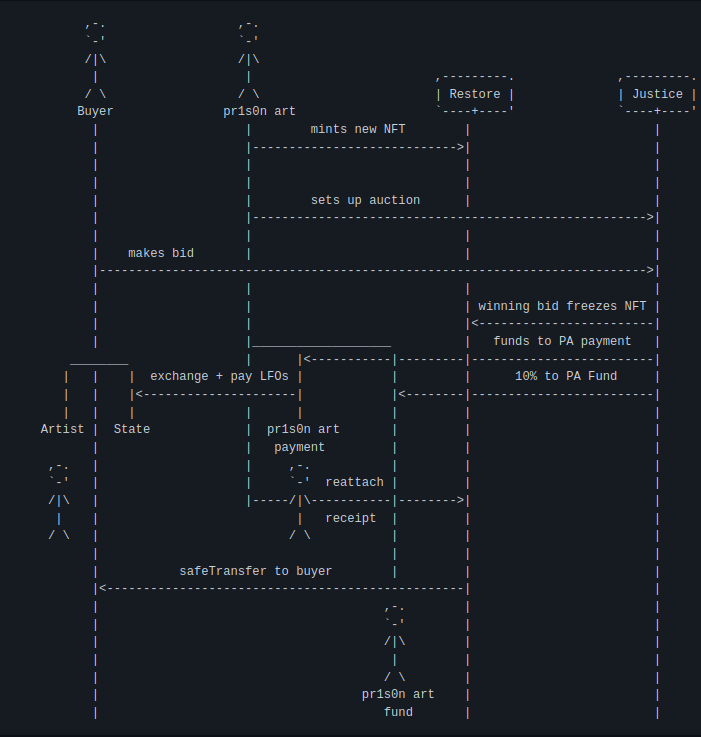
How to build humane smart contracts that restore justice and balance to a broken system.
To restore justice by interrupting the re-incarceration cycle of those unable to meet their debt.
To cultivate dignity and respect for life.
Justice involved people incur financial obligations as a result of their history and incarceration, like restitution payments for victims, court fees, and driver's license reinstatement fees. Upon release, 88% of states re-incarcerate people for failure to pay back these debts, accounting for roughly 30% of recidivism in the US.
Open, verifiable, executable contracts on ownerless networks allow us to organize institutions which are more like shared practices and customs than complex bureaucracies. We offer here a description of a shared practice for systems of restorative justice.
It is not a singular, more efficient corporation translated into code. It is a template for a way of operating previously impossible.
Art from pre-existing projects is collected, digitized, and sold as Non-Fungible Tokens on Ethereum.
The proceeds are split programmatically and transparently, according to the rules encoded into each sale.
Most of the sale proceeds are sent to an account controlled by a 501(c)(3) Nonprofit Organization, which is responsible for the exchange and payment of each of the artists' Legal Financial Obligations.
The receipts of debt payment are added back to the NFT, such that it holds not just the art, but also the transactional history of the restoration of at least one human story.
The source code is entirely open and you are welcome to fork it. It borrows heavily from many wonderful friends, to whom we are greatly indebted.
More generally, the DAO is content with low places that people disdain. It flows from the highest to the lowest, always finding and filling the empty space.

These articles all provide clear and well-researched evidence for how, and how much, debt accrues during incarceration, and the effects this has on the lives of returning citizens.
The Pr1s0n Art Project will aim to cover legal financial obligations (LFOs) ahead of other debts as these are least controversial. In 2016, returning citizens averaged ~$10k debt on release. LFOs are roughly 55% of these debts, which averages out to around $5,500 per person.
Even after serving their sentence, some former inmates are financially bound to the system for the rest of their lives. Read this research paper for further information.
Urgently building and improve justice systems that ensure fairness, promote safety, and strengthen community.
People involved with the criminal justice system in the United States are disproportionately low-income and indebted.
Entrapping debtors betrays the American idea. It must end.
These selected articles reveal how art, even in the darkest of circumstances, can serve as a creative practice of restoration to love for oneself and others.
Nicole R. Fleetwood’s powerful new book explains why.
An artist-turned-chaplain and a local muralist set out to bring art to some of some of the world’s most notorious federal inmates as a means of transformation and, hopefully, redemption.
Paños, small cloth swatches decorated with detailed illustrations by inmates, now hang in New York museums and are snapped up by worldly collectors.
A Florida exhibition of letters, poetry and drawings by inmates aims to shed light on the realities of mass incarceration
"I learned a long time ago that prison does not define us; it is what we do while we are in here that defines us."
"I think it’s really important not just to discuss the art, but to discuss the system that this art is coming out of and responding to. We’re supposedly decarcerating — people are being let out—but so many people are getting this very cruel parole. Even though we’re supposedly decarcerating, in a way we’re just expanding carceral structures. There’s also lots of entities benefitting from that. Often, people who are on life parole are wearing some kind of a monitor — they’re actually paying fees. They’re actually paying for this partial freedom."
"The thing that artwork does is it allows you to create your own value system. It’s the one thing the prison cannot take away from you. In that space of creativity, you have full autonomy and agency to do whatever you want, however you want to do it, create whatever world you want to create, and that little space can be infinite, and it’s enough to see the multitudes of everything that exists within you."
“The paño is a reminder that I’m relevant, I’m still here. I’ve got these human feelings even though I’m locked up,’”